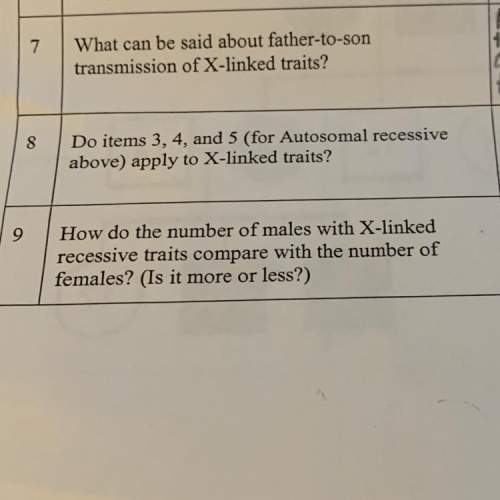Genetics Basics
Like any other language, the language of genetics consists of symbols and rule...

Biology, 24.04.2020 01:39 jeanlucceltrick09
Genetics Basics
Like any other language, the language of genetics consists of symbols and rules for using these symbols. Genetic traits are represented with letters. A capitalized letter is used to represent the dominant form of a trait (Ex. R stands for round seeds). A lower case letter is used to represent the recessive form of a trait (Ex. r stands for wrinkled seeds). Complete the following chart using these rules of symbols.
Dominant: colored seed coats, tall stems, green pods, yellow seeds, round seeds, axial flowers
Recessive: white seed coats, short stems, yellow pods, green seeds, wrinkled seeds, terminal flowers
Use the information above to fill in the chart below with the appropriate allele symbol. Seed coats are done for you!
coats
heights
pods
seed color
shape
flower
Dominant:
C-
colored seed coat
Recessive:
c-
white seed coat

Answers: 1


Another question on Biology

Biology, 22.06.2019 06:00
Which is an important function of normal flora? a. aid with bone marrow production. b. crowd out pathogenic bacteria. c. destroy digestive track pathogens. d. manufacture iron in the bloodstream.
Answers: 1

Biology, 22.06.2019 12:00
Matched chromosomes carrying information about the same characteristics in the organism are called
Answers: 1

Biology, 22.06.2019 12:10
Which number represents a basic ph, 4 or 9? numerical answers expected! answer for blank 1: i'll give
Answers: 1

Biology, 22.06.2019 17:30
Ms. w, a 21-year-old woman, came into a clinic after suffering a deep laceration on her foot while walking barefoot around her yard. the wound was cleaned, sutured, and bandaged, and she was released to return home after receiving tetanus antitoxoid. within 72 hours, the wound area was red and swollen, the suture line was dark in color, and it was accompanied by severe throbbing pain. ms. w had a high fever, her heart felt like it was racing, and she was finding it hard to concentraten even on simple tasks. she returned to the clinic and was immediately taken to the hospital. following lab tests, a diagnosis of acute necrotizing fasciitis was made. discussion questions 1. explain why ms. w. received a tetanus antitoxoid before leaving the hospital. (see chapters 3 and 4, infection and passive immunity.) 2. explain how acute necrotizing fasciitis developed in this case and the pathophysiology involved. (see acute necrotizing fasciitis.) 3. what is the potential outcome for ms. w if antibiotic drugs do not reduce the infection quickly?
Answers: 3
You know the right answer?
Questions


Mathematics, 09.01.2021 01:00

History, 09.01.2021 01:00

Physics, 09.01.2021 01:00



Mathematics, 09.01.2021 01:00



Mathematics, 09.01.2021 01:00


Mathematics, 09.01.2021 01:00



Mathematics, 09.01.2021 01:00

English, 09.01.2021 01:00

Social Studies, 09.01.2021 01:00

Engineering, 09.01.2021 01:00

Mathematics, 09.01.2021 01:00

Mathematics, 09.01.2021 01:00




